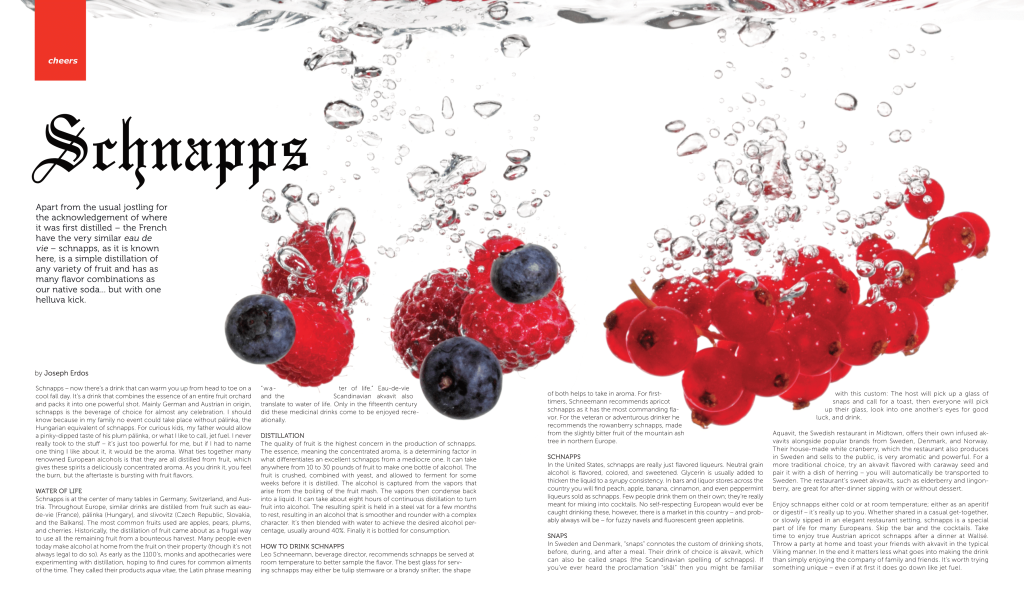
Apart from the usual jostling for the acknowledgement of where it was first distilled – the French have the very similar eau de vie – schnapps, as it is known here, is a simple distillation of any variety of fruit and has as many flavor combinations as our native soda… but with one helluva kick.
by Joseph Erdos
Schnapps – now there’s a drink that can warm you up from head to toe on a cool fall day. It’s a drink that combines the essence of an entire fruit orchard and packs it into one powerful shot. Mainly German and Austrian in origin, schnapps is the beverage of choice for almost any celebration. I should know because in my family no event could take place without pálinka, the Hungarian equivalent of schnapps. For curious kids, my father would allow a pinky-dipped taste of his plum pálinka, or what I like to call, jet fuel. I never really took to the stuff – it’s just too powerful for me, but if I had to name one thing I like about it, it would be the aroma. What ties together many renowned European alcohols is that they are all distilled from fruit, which gives these spirits a deliciously concentrated aroma. As you drink it, you feel the burn, but the aftertaste is bursting with fruit flavors.
WATER OF LIFE
Schnapps is at the center of many tables in Germany, Switzerland, and Austria. Throughout Europe, similar drinks are distilled from fruit such as eaude-vie (France), pálinka (Hungary), and slivovitz (Czech Republic, Slovakia, and the Balkans). The most common fruits used are apples, pears, plums, and cherries. Historically, the distillation of fruit came about as a frugal way to use all the remaining fruit from a bounteous harvest. Many people even today make alcohol at home from the fruit on their property (though it’s not always legal to do so). As early as the 1100’s, monks and apothecaries were experimenting with distillation, hoping to find cures for common ailments of the time. They called their products aqua vitae, the Latin phrase meaning “water of life.” Eau-de-vie and the Scandinavian akvavit also translate to water of life. Only in the fifteenth century did these medicinal drinks come to be enjoyed recreAtionally.
DISTILLATION
The quality of fruit is the highest concern in the production of schnapps. The essence, meaning the concentrated aroma, is a determining factor in what differentiates an excellent schnapps from a mediocre one. It can take anywhere from 10 to 30 pounds of fruit to make one bottle of alcohol. The fruit is crushed, combined with yeast, and allowed to ferment for some weeks before it is distilled. The alcohol is captured from the vapors that arise from the boiling of the fruit mash. The vapors then condense back into a liquid. It can take about eight hours of continuous distillation to turn fruit into alcohol. The resulting spirit is held in a steel vat for a few months to rest, resulting in an alcohol that is smoother and rounder with a complex character. It’s then blended with water to achieve the desired alcohol percentage, usually around 40%. Finally it is bottled for consumption.
HOW TO DRINK SCHNAPPS
Leo Schneemann, beverage director, recommends schnapps be served at room temperature to better sample the flavor. The best glass for serving schnapps may either be tulip stemware or a brandy snifter; the shape of both helps to take in aroma. For first-timers, Schneemann recommends apricot schnapps as it has the most commanding flavor. For the veteran or adventurous drinker he recommends the rowanberry schnapps, made from the slightly bitter fruit of the mountain ash tree in northern Europe.
SCHNAPPS
In the United States, schnapps are really just flavored liqueurs. Neutral grain alcohol is flavored, colored, and sweetened. Glycerin is usually added to thicken the liquid to a syrupy consistency. In bars and liquor stores across the country you will find peach, apple, banana, cinnamon, and even peppermint liqueurs sold as schnapps. Few people drink them on their own; they’re really meant for mixing into cocktails. No self-respecting European would ever be caught drinking these, however, there is a market in this country – and probably always will be – for fuzzy navels and fluorescent green appletinis.
SNAPS
In Sweden and Denmark, “snaps” connotes the custom of drinking shots, before, during, and after a meal. Their drink of choice is akvavit, which can also be called snaps (the Scandinavian spelling of schnapps). If you’ve ever heard the proclamation “skål” then you might be familiar with this custom: The host will pick up a glass of snaps and call for a toast, then everyone will pick up their glass, look into one another’s eyes for good luck, and drink.
Aquavit, the Swedish restaurant in Midtown, offers their own infused akvavits alongside popular brands from Sweden, Denmark, and Norway. Their house-made white cranberry, which the restaurant also produces in Sweden and sells to the public, is very aromatic and powerful. For a more traditional choice, try an akvavit flavored with caraway seed and pair it with a dish of herring – you will automatically be transported to Sweden. The restaurant’s sweet akvavits, such as elderberry and lingonberry, are great for after-dinner sipping with or without dessert.
Enjoy schnapps either cold or at room temperature; either as an aperitif or digestif – it’s really up to you. Whether shared in a casual get-together, or slowly sipped in an elegant restaurant setting, schnapps is a special part of life for many Europeans. Skip the bar and the cocktails. Take time to enjoy true Austrian apricot schnapps after a dinner at Wallsé. Throw a party at home and toast your friends with akvavit in the typical Viking manner. In the end it matters less what goes into making the drink than simply enjoying the company of family and friends. It’s worth trying something unique – even if at first it does go down like jet fuel.


